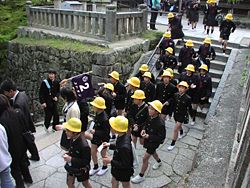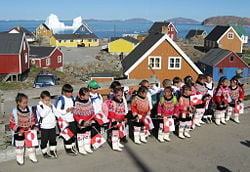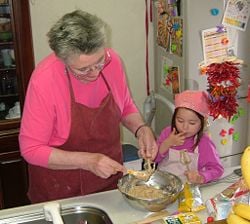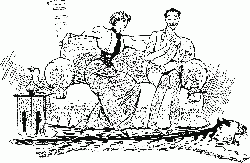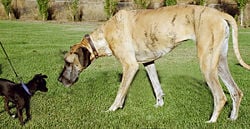Socialization
The term socialization is used by sociologists, social psychologists, and educationalists to refer to the process of learning one’s culture and how to live within it. For the individual, it provides the resources necessary for acting and participating within their society. For the society, socialization is the means of maintaining cultural continuity.
Socialization begins when the individual is born. They enter a social environment where they meet parents and other caregivers. Without such human interaction, babies suffer. Essentially social beings, all people naturally engage in relationships with others, in the family, community, school, and so forth. Each of these environments functions as a socializing agent. The family, as the first environment, is the most significant; it can be seen as the "school of love," wherein humans first experience the love of parents, siblings, and later extended family. There, the adults impart their rules of social interaction on the children, by example and by reward and discipline. This provides the foundation for the young person to live as a social being in the wider society. The successful existence and development of a society, therefore, depends to a large extent upon the socialization that children receive in their home.
History
For any society, socialization—inducting all individual members into its moral norms, attitudes, values, motives, social roles, language, and symbols—is how culture is developed and maintained.
Theories of socialization are to be found in Plato, Montaigne, and Rousseau. However, it was the response to a translation of a paper by Georg Simmel that brought the term and the idea of acquiring social norms and values into the writing of American sociologists Franklin H. Giddings and Edward A. Ross in the 1890s. In the 1920s, the theme of socialization was taken up by Chicago sociologists, including Ernest Burgess, and the process of learning how to be a member of society was explored in the work of Charles Cooley, W. I. Thomas, and George Mead.
In the middle of the twentieth century, socialization was a key idea in the dominant American functionalist tradition of sociology. Talcott Parsons and a group of colleagues in the U.S. developed a comprehensive theory of society that responded to the emergence of modernity in which the concept of socialization was a central component. One of their interests was to try to understand the relationship between the individual and society—a distinctive theme in U.S. sociology since the end of the nineteenth century.
During the last quarter of the twentieth century the concept of socialization became much less central to debates in sociology that have shifted their focus from identifying the functions of institutions and systems to describing the cultural changes of postmodernity. But the idea of socialization has lived on, particularly in debates about the family and education. The institutions of the family or the school are often blamed for their failure to socialize individuals who go on to transgress social norms. On the other hand, it is through a critique of functionalist ideas about socialization that there has been an increasing acceptance of a variety of family forms, of gender roles, and an increasing tolerance of variations in the ways people express their social identity.
Forms of socialization
Sociologists may distinguish six kinds of socialization:
- Reverse socialization
- Developmental socialization
- Primary socialization
- Secondary socialization
- Anticipatory socialization
- Resocialization
Primary socialization
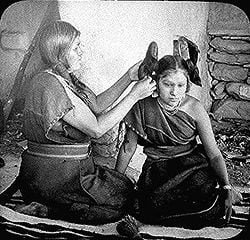
Primary socialization is the process whereby people learn the attitudes, values, and actions appropriate to individuals as members of a particular culture. Parsons saw socialization as the way that the individual was brought into society and, at the same time, it was the way that the individual was shaped as a personality. He was a sociologist, but his colleagues included psychologists and in particular Robert Bales, who was an expert on small group interaction. Their focus was on socialization through face-to-face interaction between people and they argued that the prime socializing institution was the family.
Parsons and Bales believed that human personalities are made, not born, and he described families as “'factories' which produce human personalities." He saw the family as a system that was responsible for creating the personality of individuals who would then be able to fit into the system of the whole society.
The principle function of the family was to socialize children into being full members of society through interaction. Children would imitate their parents and then modify their actions in the light of reactions that either rewarded or punished them. These interactions would initially be non-verbal but would become increasingly verbal as the child learned to talk.
Secondary socialization
Secondary socialization refers to the process of learning what is appropriate behavior as a member of a smaller group within the larger society. It is usually associated with teenagers and adults, and involves smaller changes than those occurring in primary socialization, such as entering a new profession, or relocating to a new environment or society.
If the family was the primary system of socialization, then school and the education system was the secondary mode of socialization. Interactions through imitative and communicative behavior continued to guide the emerging person through an increasingly subtle form of rewards and punishments. Harsh words of reproof gave way to poor marks, smiles and encouraging comments to merits and prizes.
Parsons and his colleagues recognized that education was not just about imparting knowledge and information but was also about shaping the personality of the individual. They saw socialization, both within the family and within the education system, as preparing the individual for their role in society; as man or woman, worker and citizen with a sense of belonging and of his or her duties and responsibilities.
Reverse socialization
Reverse socialization is deviation from the desired behaviors or enculturation, especially of the younger generation. It involves both adult and children.
Developmental socialization
Developmental socialization is the process of learning behavior in a social institution or developing one's social skills.
Anticipatory socialization
Anticipatory socialization refers to the processes of socialization in which a person "rehearses" for future positions, occupations, and social relationships. Sociologist James Henslin offers the example of a high school student who, upon hearing he had been accepted to a university, began to wear college student-type clothes:
In his last semester of high school, Michael has received word that he has been accepted to State University. Soon he begins to dismiss high school activities as being "too high school," and begins to wear clothing styles and affect mannerisms that are characteristic of State University students. Michael is exhibiting signs of anticipatory socialization.[1]
Resocialization
Resocialization refers to the process of discarding former behavior patterns and accepting new ones as part of a transition in one's life. This occurs throughout the human life cycle. Resocialization can be an intense experience, with the individual experiencing a sharp break with their past, and needing to learn and be exposed to radically different norms and values. An example might be the experience of a young man or woman leaving home to join the military.
Agents of socialization
Agents of socialization are the people and groups that influence one's self-concept, emotions, attitudes, and behavior. Some agents of socialization include the family, schools, the media, religion, the workplace, and the government.
The family
Family is responsible for, among other things, determining one's attitudes toward religion and establishing career goals. Family is an important agent of socialization by right of the sheer amount of time spent within one's family. The first few years of a child's life are likely to be spent only with their family and much of their subsequent downtime in the following years will also be spent with the family. As such, family members can teach good or bad habits regarding social interaction, adopting social norms, and inhabiting traditional roles within one's society.
The School

Outside of one's family, one probably spends the most time in school. Schoolmates, teachers, and the environment itself can have lasting impacts on a child's socialization. It is in this environment that children learn to interact with their peers, to compete, to cooperate, to respect authority, and many other valuable skills. Besides these interpersonal skills, schools are also places of learning cultural content in which one can be made aware of their society's history, traditions, and norms.
Media and socialization
Some sociologists and theorists of culture have recognized the power of mass communication as a socialization device. Dennis McQuail says:
… the media can teach norms and values by way of symbolic reward and punishment for different kinds of behavior as represented in the media. An alternative view is that it is a learning process whereby we all learn how to behave in certain situations and the expectations which go with a given role or status in society. Thus the media are continually offering pictures of life and models of behaviour in advance of actual experience.[2]
Total institutions
The term "total institutions" was coined in 1961, by Erving Goffman, designed to describe a society which is socially isolated but still provides for all the needs of its members. Therefore, total institutions have the ability to resocialize people either voluntarily or involuntarily. For example, the following would be considered as total institutions: Prisons, the military, mental hospitals, and convents.
Goffman lists four characteristics of such institutions:
- All aspects of life are conducted in the same place and under the same single authority.
- Each phase of a members daily activity is carried out in the immediate company of others. All members are treated alike and all members do the same thing together.
- Daily activities are tightly scheduled. All activity is superimposed upon the individual by a system of explicit formal rules.
- A single rational plan exists to fulfill the goals of the institution.[3]
Gender socialization and gender roles
The role of socialization in gender role development is still up for debate, although many now make the distinction between the gender role being socialized and something malleable, whereas gender or sex is biologically determined.
The development of one's gender role plays a tremendous role in socialization as people are expected to conform to traditionally accepted roles while taking their place in society. In the past, this has taken the form of certain forms of employment being reserved or predominantly held by members of one gender or another (such as teachers are women and bankers are men). This rigid structure is beginning to shift as gender roles are reconsidered, but still remains a key aspect to socialization.
A gender role is a set of behavioral norms associated particularly with males or females in a given social group or system, often including the division of labor between men and women and the attendant complex of child-rearing and socialization processes leading youth toward maturing to perpetuate the same pattern. Gender-based roles coincident with sex-based roles have been the norm in many traditional societies, with the specific components and workings of the gender/sex system of role division varying markedly from society to society.
A person's gender role comprises several elements that can be expressed through clothing, behavior, occupation, personal relationships, and other factors. These elements are not fixed and have changed through time (for example, women's trousers). Gender roles traditionally were often divided into distinct feminine and masculine gender roles, until especially the twentieth century, when these roles diversified into many different acceptable male or female roles in modernized countries throughout the world. Thus, in many modern societies one's biological gender no longer determines the functions that an individual can perform, allowing greater freedom and opportunity for all people to express their individual talents and interests.
Within the family in modern societies, there remains considerable flux over gender roles, including the emergence of the "working mother" and the "stay-at-home" father, which run opposite to previous generations' expectations. Yet, many families retain a more traditional structure, with their children maintaining the traditional gender roles. Such occurrence offers little in the debate over whether gender roles can be socialized without any limit, since socialization influences within the family, extended family, and local community could have prevailed over the alternatives offered by the mass media and wider society.
Socialization of animals
The process of intentional socialization is central to training animals to be kept by humans in close relationship with the human environment, including pets and working dogs. Feral animals can be socialized with varying degrees of success.
For example, the cat returns readily to a feral state if it has not been socialized properly in its young life. A feral cat usually acts defensively, which people may unknowingly think is merely "unfriendly" behavior. Allowed to proliferate, such creatures become a nuisance. However, feral cats are sometimes helpful when used in agriculture to keep rodent and snake populations down.
In domesticated dogs, the process of socialization begins even before the puppy's eyes open. Socialization refers to both its ability to interact acceptably with humans and its understanding of how to communicate successfully with other dogs. If the mother is fearful of humans or of her environment, she can pass along this fear to her puppies. For most dogs, however, a mother who interacts well with humans is the best teacher that the puppies can have. In addition, puppies learn how to interact with other dogs by their interaction with their mother and with other adult dogs in the house.
Dogs who are well socialized from birth with both dogs and many other species, especially with people, who are much less likely to be aggressive, to suffer from fear-biting, or to interact undesirably with either species. They are more likely to be calm and interested in even the most unusual situations.
Notes
- ↑ James Henslin, Essentials of Sociology: A Down-to-Earth Approach, (Allyn & Bacon, 2006, ISBN 978-0205504404)
- ↑ Dennis McQuail, McQuail's Mass Communication Theory (Sage Publications, 2005). ISBN 1412903726
- ↑ Erving Goffman, Asylums: Essays on the Social Situation of Mental Patients and Other Inmates (Anchor, 1961). ISBN 0385000162
ReferencesISBN links support NWE through referral fees
- Bayley, Robert. Language Socialization in Bilingual and Multilingual Societies. Multilingual Matters, 2003. ISBN 1853596361
- Berns, Roberta. Child, Family, School, Community: Socialization and Support. Wadsworth, 2007. ISBN 0495504548
- Clausen, John A., ed. Socialization and Society. Boston: Little Brown and Company, 1968.
- Goffman, Erving. Asylums: Essays on the Social Situation of Mental Patients and Other Inmates. Anchor, 1961. ISBN 0385000162
- Grusec, Joan. Handbook of Socialization: Theory and Research. Guilford Press, 2006. ISBN 1593853327
- Handel, Gerald. Children and Society: The Sociology of Children and Childhood Socializationm. Oxford University Press, 2007. ISBN 0195330781
- Henslin, James. Essentials of Sociology: A Down-to-Earth Approach. Allyn & Bacon, 2006. ISBN 978-0205504404
- Kulick, Don. Language Shift and Cultural Reproduction: Socialization, Self and Syncretism in a Papua New Guinean Village. Cambridge University Press, 1997. ISBN 0521599261
- McDowell, Susan. But What About Socialization? Answering the Perpetual Home Schooling Question: A Review of the Literature. Philodeus Press, 2004. ISBN 0974407801
- McQuail, Dennis. McQuail's Mass Communication Theory. Sage Publications, 2005. ISBN 1412903726
Credits
New World Encyclopedia writers and editors rewrote and completed the Wikipedia article in accordance with New World Encyclopedia standards. This article abides by terms of the Creative Commons CC-by-sa 3.0 License (CC-by-sa), which may be used and disseminated with proper attribution. Credit is due under the terms of this license that can reference both the New World Encyclopedia contributors and the selfless volunteer contributors of the Wikimedia Foundation. To cite this article click here for a list of acceptable citing formats.The history of earlier contributions by wikipedians is accessible to researchers here:
The history of this article since it was imported to New World Encyclopedia:
Note: Some restrictions may apply to use of individual images which are separately licensed.
